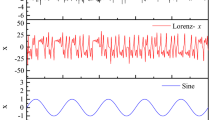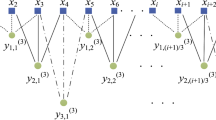Abstract
Disclosing the nonlinear flow structure of oil–gas–water three-phase flows has always been a challenging problem. Rescaled range permutation entropy is recently introduced as a new method to measure the complexity of chaotic sequences with extreme mutation. However, the combination of multiscale method and rescaled range permutation entropy in previous work is unreliable because multiscale method shows significant fluctuation on different lengths of time series and especially on high time scales. Therefore, we propose the refined composite rescaled range permutation entropy to analyze the nonlinear flow structure of oil–gas–water three-phase flows. A multi-channel rotating electric field conductance sensors signals are utilized to capture detailed flow structure information in 20-mm inner diameter pipe from different positions of pipe cross section. Then, we discussed a practical application of the refined composite rescaled range permutation entropy in experimental signals analysis of oil–gas–water three-phase flows in detail. The results show that the refined composite rescaled range permutation entropy has a significant discernibility and representational capacity on quantifying the complexity of oil–gas–water three-phase flows under different conditions. Proving that the combination of the rescaled range permutation entropy and the refined composite coarse-grain method can fully and stably represent the complexity of a class of engineering signals, especially with extreme volatility. On this basis, we first extract the normalized mean value on the whole scale and the normalized difference between the intercept on the high-scale and low-scale fitting curves of the refined composite rescaled range permutation entropy to form the joint plot to analyze the nonlinear flow structure. The results show that the analysis is sensitive and robust to the change of the multivariate signals of the internal dynamic flow structure. This study provides a novel method to be employed to characterize and to classify the complexity of the internal flow structure of oil–gas–water three-phase flows under different working conditions. And it can be applied to quantifying the complexity of a series of fluctuating signals to varying degrees, even some abrupt changes in some complicate systems.








Similar content being viewed by others
Data availability statements
The datasets generated and analyzed during the current study will be available from the corresponding author on reasonable request.
References
M. Açikgöz, F. França, R.T. Lahey Jr., Int. J. Multiphase Flow 18, 327 (1992)
C.S. Cheng, D. Shirmohammadi, IEEE T. Power Syst. 10, 671 (1995)
G.S. Woods, P.L. Spedding, J.K. Watterson, R.S. Raghunathan, Trans IChemE 76, 571 (1998)
S. Wang, H.Q. Zhang, C. Sarica, E. Pereyra, Spe. Prod. Oper. 28, 306 (2012)
Z.K. Gao, N.D. Jin, Chem. Eng. Sci. 66, 2660 (2011)
J.Y. Zhao, N.D. Jin, Z.K. Gao, M. Du, Z.Y. Wang, Chin. Phys. B 23, 034702 (2014)
A. Zhao, N.D. Jin, Y.Y. Ren, L. Zhu, X.Z. Yang, Z. Naturforsch. A 71, 33 (2016)
S.M. Pincus, A.L. Goldberger, Am. J. Physiol-Heart C 266, 1643 (1994)
H. Yang, S. Amari, Neural Comput. 9, 1457 (1997)
E. Pereda, R.Q. Quiroga, J. Bhattacharya, Prog. Neurobiol. 77, 1 (2005)
C.J. Stam, Clin. Neurophysiol. 116, 2266 (2005)
C. Gómez, R. Hornero, D. Abásolo, A. Fernández, J. Escudero, Ann. Biomed. Eng. 37, 586 (2009)
S. He, K. Sun, S. Banerjee, Eur. Phys. J. Plus 131, 254 (2016)
N. Cabo Bizet, O. Obregón, Eur. Phys. J. Plus 133, 55 (2018)
J.S. Richman, J.R. Moorman, Am. J. Physiol-Heart C 278, H2039 (2000)
M. Costa, A.L. Goldberger, C.K. Peng, Phys. Rev. Lett. 89, 068102 (2002)
H. Azami, J. Escudero, Physica A 465, 261 (2017)
C. Bandt, B. Pompe, Phys. Rev. Lett. 88, 174102 (2002)
Y. Cao, W.W. Tung, J.B. Gao, V.A. Protopopescu, L.M. Hively, Phys. Rev. E 70, 046217 (2004)
M. Zanin, L. Zunino, O.A. Rosso, D. Papo, Entropy 14, 1553 (2012)
X. Li, G. Ouyang, D.A. Richards, Epilepsy Res. 77, 70 (2007)
L. Zunino, M. Zanin, B.M. Tabak, D.G. Pérez, O.A. Rosso, Physica A 389, 1891 (2009)
B. Fadlalah, B.D. Chen, A. Keil, J. Príncipe, Phys. Rev. E 87, 022911 (2013)
Y. Yin, P.J. Shang, Nonlinear Dyn. 88, 1707 (2017)
Y.D. Liu, D.Y. Wang, Y.Y. Ren, N.D. Jin, Z. Naturforsch. A 74, 837 (2019)
J.C. Zhang, W.K. Ren, N.D. Jin, Chin. Phys. Lett. 37, 090501 (2020)
W.K. Ren, J.C. Zhang, N.D. Jin, Nonlinear Dyn. 104, 4035 (2021)
Y.P. Zhang, P.J. Shang, Physica A 496, 189 (2018)
D.Y. Wang, N.D. Jin, L.X. Zhuang, L.S. Zhai, Y.Y. Ren, Meas. Dci. Technol. 29, 075301 (2018)
Acknowledgments
This study was supported by National Natural Science Foundation of China (Grant Nos. 42074142, 51527805).
Author information
Authors and Affiliations
Corresponding author
Rights and permissions
About this article
Cite this article
Zhang, J., Jin, N. & Ren, W. Detecting the fluid flow transitions in oil–gas–water three-phase flows using multivariate rescaled range permutation entropy analysis. Eur. Phys. J. Plus 137, 808 (2022). https://doi.org/10.1140/epjp/s13360-022-03026-6
Received:
Accepted:
Published:
DOI: https://doi.org/10.1140/epjp/s13360-022-03026-6




